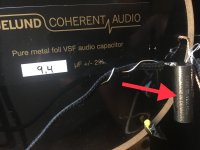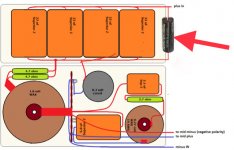Hi,
I have a 3-way DIY loudspeakers with a second-order crossover on all three channels. Some time ago I discovered the advantages of using the bypass capacitors in the high frequency section of the crossover. Specifically, I use the Duelund silver bypass of 0.01 uf. The result is very positive: they provide more clarity and detail to the top end.
My query is to what extent this resource (using a bypass cap) can be useful in the mid section of my crossover. Should it be installed as indicated for high frequencies? (That is, in parallel with the original cap? My doubt is given because in the media a high pass filter and a low pass filter is combined and I am not sure how the use of a bypass would be maximized.
On the other hand, I have clear sound improvement when using quality caps. Using quality caps in the high frequency section can be expensive but it is possible. However, in the mids section the thing is much more complicated by the value of the caps used. In my loudspeakers I use 4 caps of 22uf of Jantzen Superior Z-cap. Replacing all of them with others of higher quality and sound is an unbearable cost for me. A possible solution is the improvement with a bypass, as I have said before, but it could also be combined with the Z-caps, other condensers of lesser value but that could provide an improvement in sound. For example, in a total value of 88uf, use 80uf of the Z-caps and 8uf of another better cap. Anyone have knowledge or experience of what is the minimum value of a cap for this possible solution to work? 1 pfu? two? 4?….
BR
Toni
I have a 3-way DIY loudspeakers with a second-order crossover on all three channels. Some time ago I discovered the advantages of using the bypass capacitors in the high frequency section of the crossover. Specifically, I use the Duelund silver bypass of 0.01 uf. The result is very positive: they provide more clarity and detail to the top end.
My query is to what extent this resource (using a bypass cap) can be useful in the mid section of my crossover. Should it be installed as indicated for high frequencies? (That is, in parallel with the original cap? My doubt is given because in the media a high pass filter and a low pass filter is combined and I am not sure how the use of a bypass would be maximized.
On the other hand, I have clear sound improvement when using quality caps. Using quality caps in the high frequency section can be expensive but it is possible. However, in the mids section the thing is much more complicated by the value of the caps used. In my loudspeakers I use 4 caps of 22uf of Jantzen Superior Z-cap. Replacing all of them with others of higher quality and sound is an unbearable cost for me. A possible solution is the improvement with a bypass, as I have said before, but it could also be combined with the Z-caps, other condensers of lesser value but that could provide an improvement in sound. For example, in a total value of 88uf, use 80uf of the Z-caps and 8uf of another better cap. Anyone have knowledge or experience of what is the minimum value of a cap for this possible solution to work? 1 pfu? two? 4?….
BR
Toni
Attachments
Bypass caps must make up a significant portion of the total capacitance to have a significant effect at audio frequencies.* The former 'significant' can be interpreted as one third. More important is to keep the total capacitance the same. That means that you have to take out some of the old capacitance, before you add the bypass capacitor.
* And the large capacitor must have sub-par performance, obviously. Except for electrolytic capacitors, they usually are quite good.
* And the large capacitor must have sub-par performance, obviously. Except for electrolytic capacitors, they usually are quite good.
Last edited:
0.01uF (10nF) will have a reactance of over 15k ohms at 1kHz. To even bring that down to 15 ohms would require 10uF.
-I think TONI G should ask Tony Gee:
Humble Homemade Hifi - Contact ? Disclaimer ? Privacy ? Copyright
Humble Homemade Hifi - Contact ? Disclaimer ? Privacy ? Copyright
Hi Toni,
I have tried the silver foil caps as bypass caps with my Clarity CMR 10uF caps. I used 0.047 uF values and ended up selling them as being too small to be useful. For my money, the Audyn 0.1uF True Copper was much more effective, and at around $20, a lot cheaper. 🙂
Best,
E
I have tried the silver foil caps as bypass caps with my Clarity CMR 10uF caps. I used 0.047 uF values and ended up selling them as being too small to be useful. For my money, the Audyn 0.1uF True Copper was much more effective, and at around $20, a lot cheaper. 🙂
Best,
E
Toni,
You could, as an experiment, make your own bypass capacitors if you are convinced they actually improve the sonics of your loudspeakers. It would virtually cost you nothing but effort although impractical in size, simply use Alfoil and a dialectic of Glad Wrap (food wrap). One might think that idea is rather silly which indeed it is, but it would prove the point that bypass caps are simply pretentious in their use in crossover networks at audio frequencies. If you want to 'lift' the midrange somewhat supposedly to increase midrange clarity why not use the tone controls of your amplfier (if it has some) and that should do the trick. Wasting money on such trivial pursuits as bypass capacitors would be better spent elsewhere, sorry to be so blunt but the marketing of 'enhancements' is just that ... marketing.
C.M
You could, as an experiment, make your own bypass capacitors if you are convinced they actually improve the sonics of your loudspeakers. It would virtually cost you nothing but effort although impractical in size, simply use Alfoil and a dialectic of Glad Wrap (food wrap). One might think that idea is rather silly which indeed it is, but it would prove the point that bypass caps are simply pretentious in their use in crossover networks at audio frequencies. If you want to 'lift' the midrange somewhat supposedly to increase midrange clarity why not use the tone controls of your amplfier (if it has some) and that should do the trick. Wasting money on such trivial pursuits as bypass capacitors would be better spent elsewhere, sorry to be so blunt but the marketing of 'enhancements' is just that ... marketing.
C.M
I would use the bypass in the mids also instead of buying the more expensive caps (if of superior quality like you said).
My question about the same question, with woofer filter.
Klipsch Forte III Upgrade with Pictures!
The answer:
Klipsch Forte III Upgrade with Pictures!
Klipsch Forte III Upgrade with Pictures!
The answer:
Klipsch Forte III Upgrade with Pictures!
Danny [Richie] mentioned to me at anything over .1uf in a bypass cap will start to have phase shift issues.
why would > 0.1 uF be a problem (other than more cost for a given brand) with a passive crossover bypass cap ? Using bypass caps with relatively high ESR might not do much. Some zero loop feedback tube amps don't go very high in frequency.
Last edited:
I’ve had .01uf make a noticeable difference in certain situations, and none at all other times.
I usually bypass the mids the same as the tweeters when both have similar base capacitors.
I usually bypass the mids the same as the tweeters when both have similar base capacitors.
- Home
- Loudspeakers
- Multi-Way
- bypass caps in a mids crossovers

